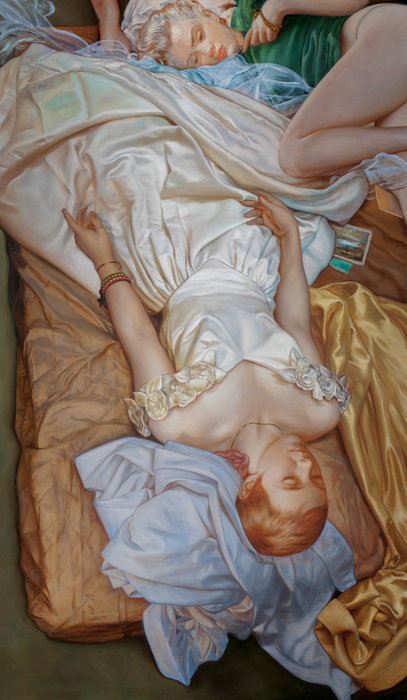NIAGARA SERIES (2012 - 2014)
"Now, however, [in the Niagara series] we enter a strictly post-adolescent realm. The process begins in the transitional, topsy-turvy, toddler-titled Jeannie Big Bed. The Seberg-muse has had an awakening and precipitously she possesses a soul. The last thing that would have occurred to her in her past incarnation was that she might develop a conscience – and so the last thing on her mind now is sex-work. The room around her, and all her former selves, fall away like so many shed skins, and cinematically, she gazes off-stage, off the lot, as it were, to where her future lays.
It lays in niagaradown where something like The Raft of the Medusa has shipwrecked seven characters in search of a plot. Having survived the catastrophe of the waterfall, they take stock of their plight. An eighth figure, arms folded, voyeuristically observes the scene from the middle distance. In Regency attire, an appropriated stand-in for the former boy-figure occupies the center of the painting. A young poet glances across the picture-plane towards an introspective ingénue. These archetypes embody the problems of post-adolescence: that is to say the moment of recognition that one is completely alone in the universe, that one must die alone, and that in between one must somehow find solace for existence - and so we become embroiled in all manner of intrigues. Our supreme task is to avoid ennui, disillusionment, and the death of the spirit. The script calls for action, but these characters can only long for a day when they might achieve praxis, or perhaps find love and fulfillment."
excerpt from "Pathos & Enlightenment" essay by Dick Goody, Director, Oakland University Gallery
I’ve been somewhat obsessed with a particular painting of late: Francesco Solimena’s Dido receiving Aeneas and Cupid disguised as Ascanius (probably 1720s) from the collection of London’s National Gallery. Not necessarily one of the most celebrated works of the 18th Century but one with particular personal significance courtesy of its being featured on one of my favorite albums growing up—RCA Camden Classics recording of Mozart’s 41st “Jupiter” Symphony by Erich Leinsdorf and the Boston Symphony Orchestra. Though lacking a direct connection between the “classical” personages in consideration (it’s not the “Dido,” “Aeneas,” or “Cupid” Symphony after all), the grandeur of the figures’ gestures and the intensity and urgency created by the interplay of rich colors, sumptuously depicted fabrics, and dramatic rendering of light and shadow felt very visually equal to what is perhaps Mozart’s most daring and thrilling composition (particularly the fourth movement.) Looking at the painting again, independent of the context of the album cover, I still get a weird synaesthetic rush of sonic dynamism is the process of perceiving its formal composition, its colors, and its forms.
Solimena’s work remains in my frontal lobe and had a profound impact on my impression of seeing Jamie Adams’ most recent group of paintings in his studio last week. Soon to be presented in an exhibition at David Klein Gallery in Birmingham, Michigan (opening May 3rd), the suite of ten works ranges from larger canvases of groups of figures to smaller (but not necessarily small) portraits. My most immediate previous experience with Adams’ work had been a 2011 solo presentation at Phil Slein Gallery in St. Louis soon after I had arrived in the city—an exhibition characterized by paintings both featuring the likeness of tragic American film star Jean Seberg in various roles (and states of dress and undress) and rendered in a strict palette of black, white, and gray. While Seberg’s reappearance gave the new works a certain familiarity, I was completely unprepared for the sensual colors and textures and the often unusual perspectives, scenarios, and compositions that characterize this most recent body of work. The heroically scaled groupings of figures possess an undeniable affinity with pre-Modernist history paintings—certainly a reason that Dido receiving Aeneas came so quickly to mind—and Adams’ open acknowledgement of precedents such as Rembrandt van Rijn’s The Anatomy Lesson of Doctor Tulp (1632) or Thomas Eakins’ The Swimming Hole (1883) certainly reinforce that association. There was also something very Renoir about the pinks and pastels of the fabrics, fleshtones, and other surfaces. Yet the effect of lighting within the works, as well as complicated compressions of space, suggest a more current cinematic sensibility. Subjects appear to be lit with color filtering gels, while certain angles feel less painterly than framed by a hand-held camera. The frequent use of Niagara Falls-esque backgrounds—suggesting for Adams a certain sublime sense of catastrophe or dread—recall the rear projection of classic Hitchcock.
Perhaps it’s not so much Solimena’s painting in and of itself that came to mind in the experience of Adams’ recent work but rather its utilization in the contemporary context of an album cover (albeit for a performance of music composed not too long (1788) after the painting was produced.) There’s something refreshingly current about the unapologetically traditional appearance and classical demeanor of these paintings. For all of their incorporation of touches of “presentness”—from the aforementioned allusions to movies and film to the “meta” rendering of paintings (and drawings) within the paintings—Adams’ works ultimately feel historically informed but hardly dated. Quite possibly, the paintings exceed their two-dimensionality to synaesthetically convey physical, auditory, and sensual experiences, a tendency one associates more with immersive multimedia installations than with the more conventional format of highly representational painting.
Dominic Molon
Contemporary Art Curator, RISD Museum
(Visit to Jamie Adams’ studio April 2013)









